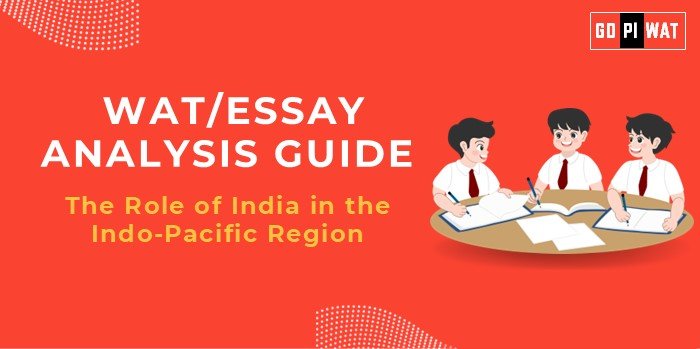📋 WAT/Essay Analysis Guide: The Role of India in the Indo-Pacific Region
🌟 Understanding the Topic’s Importance
India’s role in the Indo-Pacific ties directly to themes of economic development, global trade, and security. This topic enables students to analyze real-world applications of policy-making and strategic partnerships relevant for B-school projects.
📝 Effective Planning and Writing
- ⏳ Time Allocation:
- 🕒 Planning: 5 minutes
- ✍️ Writing: 20 minutes
- 🔍 Review: 5 minutes
- 💡 Preparation Tips:
- 📊 Note key statistics on trade, maritime security, and climate initiatives.
- 🔍 Understand stakeholder roles and regional geopolitics.
💡 Introduction Techniques for Essays
- ✨ Contrast Approach:
“While the Indo-Pacific thrives as the global trade nerve center, escalating geopolitical tensions question its stability and inclusivity.”
- 🔧 Solution-Based:
“India’s Act East and SAGAR policies illustrate a proactive approach to balancing economic growth with regional stability.”
🔍 Structuring the Essay Body
- 🏆 Achievements: Highlight India’s growing economic ties, Quad contributions, and leadership in maritime diplomacy.
- ⚖️ Challenges with Comparative Analysis: Discuss rivalries with China and infrastructure gaps, with comparisons to global initiatives like the Belt and Road.
- 🌍 Future Outlook: Emphasize India’s potential as a regional leader in sustainability and digital trade.
✅ Concluding Effectively
- ⚖️ Balanced Perspective:
“India’s Indo-Pacific engagement demonstrates both achievements and challenges, demanding a nuanced strategy for sustainable leadership.”
- 🌐 Global Example Comparison:
“Drawing lessons from Japan and Singapore, India can evolve into a regional powerhouse with strategic investment and multilateralism.”
📈 Recommendations for Sustainable Progress
- ⚓ Enhance maritime infrastructure and connectivity.
- 🤝 Promote inclusive trade agreements across the region.
- 🌱 Invest in climate resilience projects.
📄 Sample Short Essays
1. Balanced Perspective:
“India’s strategic engagement in the Indo-Pacific, from Quad collaborations to economic ties, positions it as a key regional player. Yet, challenges like infrastructural gaps and geopolitical tensions demand nuanced approaches for sustained impact.”
2. Solution-Oriented:
“India’s Act East and SAGAR policies showcase its commitment to a stable Indo-Pacific. By focusing on green infrastructure and inclusive trade, India can lead the region towards sustainable growth.”
3. Global Comparison:
“Learning from global benchmarks like Japan’s disaster resilience and Singapore’s digital economy, India can enhance its role in the Indo-Pacific by integrating innovation with diplomacy.”


